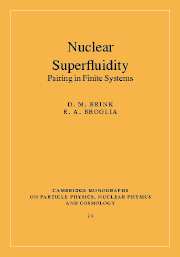Book contents
- Frontmatter
- Contents
- Preface
- 1 Introduction
- 2 The pairing force and seniority
- 3 The BCS theory
- 4 Spontaneous symmetry breaking
- 5 Pairing vibrations
- 6 Phase transitions
- 7 Plastic behaviour of nuclei and other finite systems
- 8 Sources of pairing in nuclei
- 9 Beyond mean field
- 10 Induced interaction
- 11 Pairing in exotic nuclei
- Appendix A A brief résumé of second quantization
- Appendix B Single particle in a non-local potential
- Appendix C Useful relations in the treatment of collective modes
- Appendix D Particle-vibration coupling
- Appendix E Model of the single-particle strength function
- Appendix F Simple model of Pauli principle corrections
- Appendix G Pairing mean-field solution
- Appendix H Pairing in a single j-shell
- Appendix I Fluctuations and symmetry restoration
- Appendix J RPA solution of the pairing Hamiltonian
- Appendix K Vortices in nuclei
- Appendix L Josephson effect
- References
- Index
10 - Induced interaction
Published online by Cambridge University Press: 17 August 2009
- Frontmatter
- Contents
- Preface
- 1 Introduction
- 2 The pairing force and seniority
- 3 The BCS theory
- 4 Spontaneous symmetry breaking
- 5 Pairing vibrations
- 6 Phase transitions
- 7 Plastic behaviour of nuclei and other finite systems
- 8 Sources of pairing in nuclei
- 9 Beyond mean field
- 10 Induced interaction
- 11 Pairing in exotic nuclei
- Appendix A A brief résumé of second quantization
- Appendix B Single particle in a non-local potential
- Appendix C Useful relations in the treatment of collective modes
- Appendix D Particle-vibration coupling
- Appendix E Model of the single-particle strength function
- Appendix F Simple model of Pauli principle corrections
- Appendix G Pairing mean-field solution
- Appendix H Pairing in a single j-shell
- Appendix I Fluctuations and symmetry restoration
- Appendix J RPA solution of the pairing Hamiltonian
- Appendix K Vortices in nuclei
- Appendix L Josephson effect
- References
- Index
Summary
As discussed in the last section of Chapter 9 a pair of nucleons can interact with each other through the nuclear surface in a process in which one nucleon excites a vibrational mode which is then absorbed by the other nucleon (see inset Fig. 10.1). This process leads to a renormalization of the nucleon–nucleon interaction which, for nucleons close to the Fermi energy, is controlled by the exchange of low-lying surface collective vibrations. This is because low-energy surface vibrations match the frequencies of these nucleons and are very collective. This argument is the same as that used to explain the central role of surface vibrations in renormalizing the single-particle motion. The contribution of surface vibrations to the single-particle self-energy and to the ω-mass was analysed in Chapter 9 and a simplified version of the particle-vibration coupling model was introduced in Section 9.3. It gave explicit expressions for both the ω-mass and the induced pairing interaction and pairing gap due to phonon exchange. They both have a simple dependence on the coupling strength gp-v which is defined in equation (9.31). The present chapter extends the discussion of the induced interaction and presents the results of microscopic calculations. Section 10.3 presents results in a slab model, where the simplicity of the infinite system is retained (absence of shell structure), without losing surface effects.
- Type
- Chapter
- Information
- Nuclear SuperfluidityPairing in Finite Systems, pp. 219 - 256Publisher: Cambridge University PressPrint publication year: 2005

